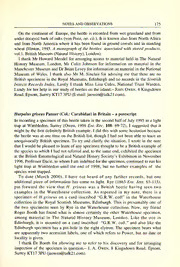
Harpalus griseus Panzer (Col.: Carabidae) in Britain: A postscript PDF
Preview Harpalus griseus Panzer (Col.: Carabidae) in Britain: A postscript
NOTESANDOBSERVATIONS 175 On the continent of Europe, the beetle is recorded from wet grassland and from under decayed bark ofoaks (von Peez, op. cit.). It is known also from North Africa and from North America where it has been found in ground cereals and in standing wheat (Hinton, 1945. A monograph ofthe beetles associated with storedproducts. vol.1. BritishMuseum (NaturalHistory), London). I thank Mr Howard Mendel for arranging access to material held in The Natural History Museum, London, Mr Colin Johnson for information on material in the ManchesterMuseum andDrBrian Levey forinformation onmaterial inthe National Museum of Wales. I thank also Mr M. Sinclair for advising me that there are no British specimens in the Royal Museums, Edinburgh and no records in the Scottish Insects Records Index. Lastly I thank Miss Lisa Coles, National Trust Warden, Lundy forherhelp in our study ofbeetles on the island.-John Owen, 8 Kingsdown Road,Epsom, Surrey KT17 3PU (E-mail:jaowen(a)talk21.com). HarpalusgriseusPanzer (Col.: Carabidae) in Britain-a postscript Inrecording a specimen ofthis beetle taken inthe secondhalfofJuly 1995 in a light trap at Wimbledon, Surrey (Owen, 1996 Ent. Rec. 108: 69-72), I suggested that it might be the first definitely British example. I did this with some hesitation because the beetle was at one time on the British list, though I had not been able to trace an unequivocally British specimen. To try and clarify the situation, I wrote in the note that I would be pleased to learn ofany specimen thought to be a British example of the species to which I had not referred and, to the same end, exhibited the specimen at the British Entomological and Natural History Society's Exhibition in November 1996. ProfessorDacie, towhom I am indebted forthe specimen, continuedtorun his light trap at Wimbledon until the end of 1998, but no further examples of the specieswere trapped. To date (March 2000), I have not heard of any further records, but one additional piece of information has come to light. Rye (1863 Ent. Ann. 65-115), put forward the view that H. griseus was a British beetle having seen two examples in the Waterhouse collection. As reported in my note, there is a specimen of H.griseus on a card inscribed "G.R.W. coll" in the Waterhouse collection in the Royal Scottish Museums, Edinburgh. This is presumably one of the two specimens seen by Rye in the Waterhouse collection. Now, my friend Roger Booth has found what is almost certainly the other Waterhouse specimen, among material in The Natural History Museum, London. Like the one in Edinburgh, it is mounted on a card inscribed "G.R.W. coll." and also like the Edinburgh specimen has a pin-hole in the right elytron. The specimen bears what are apparently two accession labels, one of which refers to Power, but no date or locality is given. I thank Dr Booth for allowing me to refer to his discovery and for arranging inspection of the specimen in question.- J. A. Owen, 8 Kingsdown Road, Epsom, SurreyKT17 3PU (jaowen(a)talk21.com).
